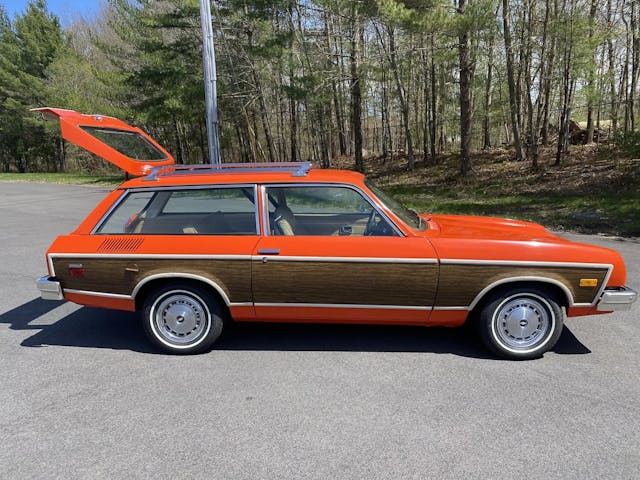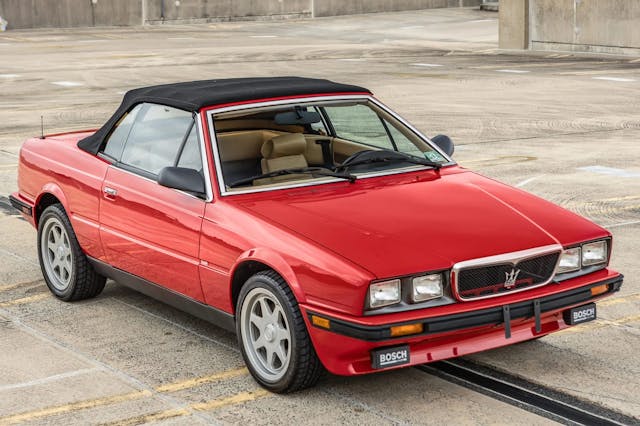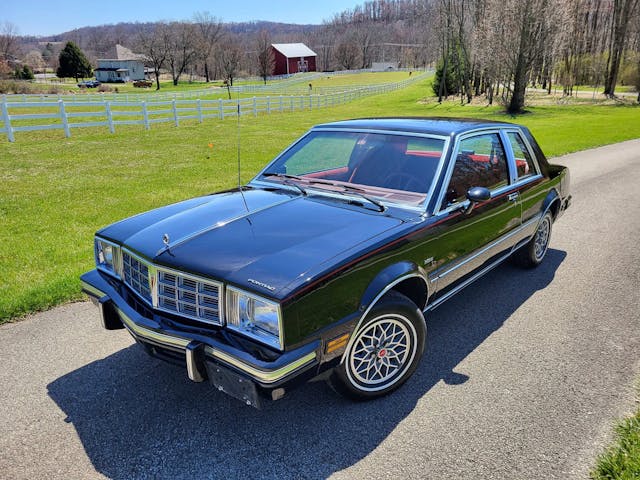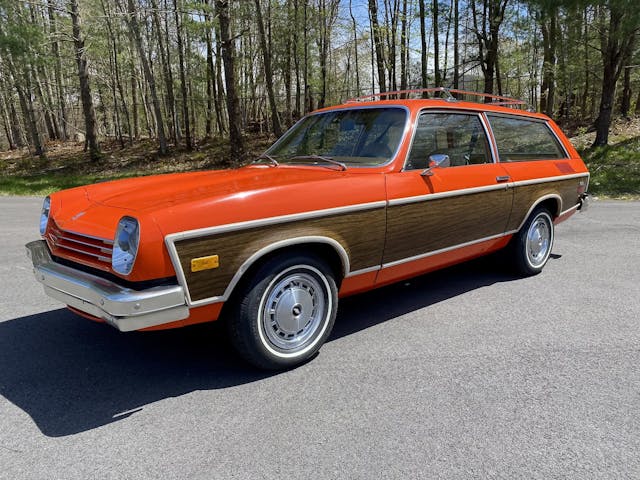5 Cars That Prove There’s Love for the Unexceptional
Almost ten years ago, I was part of the team that gave birth to a much-loved Hagerty U.K. event: The Festival of the Unexceptional. FOTU, to this day, is a celebration of extraordinary examples of the most mundane—and in some cases, plain disappointing—automobiles ever built. The event made people realize how low the survivorship rate is for many of these generally unloved cars. These days, the market is perhaps finally waking up to the fact that many of the cars that were the butt of jokes—the rides that were the one-time Nickelbacks of the automotive world—are now legitimately rare and interesting collector cars. Lately, we’ve taken note of some eye-popping sales (and enthusiastic bids that somehow didn’t meet reserve) of what are, almost certainly, the sweetest examples of some of the most maligned cars ever made. We submit these for your disapproval:
1977 Chevrolet Chevette

Sold for $22,050
When the Chevette debuted in the U.S. for the 1976 model year, it already seemed like a vestige of a prior era. It was rear-wheel drive at a time when small cars like the Fiat 128 and VW Golf/Rabbit had demonstrated that the future of the compact car was in powering the front wheels. The Chevette was middling but apparently sturdy, until rust claimed almost all of them.
This light blue one showed 5000 miles on the odometer and was lavishly equipped with full wheel covers and an AM/FM radio. Oh, and it had A/C too, something which no doubt sapped at least 15 of the 60 available horses. The shocking final price of $21,000 reflects the fact that while these cars have all but disappeared, nearly everybody of a certain age seems to have a fond Chevette story. Good memories in maligned cars are still good memories.
1976 Chevrolet Vega

Sold for $12,337
The Vega was less of a joke than a genuine Greek tragedy. It could have been a really decent car but for GM’s dreadful execution. It was pretty, handled well, and it was affordable. Sadly, the prone-to-overheating aluminum-block engines had a two-stroke’s appetite for oil, and the only way in which Vegas were competitive with Toyotas of the day was in their penchant for the tin worm.
True story: My best friend in high school owned a five-year-old Kammback just like this one. It only had 40,000 miles on it, but it used a quart of oil with nearly every fill-up. The car’s cowl had rusted so badly that the windshield was slipping down towards the firewall, leaving a half-inch gap at the top where air would rush in. My solution was to wad up some newspaper to prop up the piece of glass. Pretty elegant if I do say so myself. This example is almost impossibly rust-free, especially for one with 70,000 miles. For heaven’s sake, there’s even a receipt for rebuilding the 8-track player. And that pretty much explains the car’s state of preservation. The new owner shipped it to France, where it’s reputed to be the only one in the country.
1989 Maserati BiTurbo

Bid to $16,750
The BiTurbo had among the worst reputations of cars sold in the U.S. in the 1980s. Early carbureted examples had a propensity to catch fire from running too rich of a mixture through the cats, and the fallout nearly destroyed Maserati’s status as a prestige brand. I suppose it made sense at the time; the BiTurbo was positioned as a more potent, more luxurious, and slightly more expensive competitor to the E30-generation BMW 3-series. Instead, to many, it came off as a cynical cash grab by Maserati’s owner, Alejandro De Tomaso. To my eyes, it also looked disturbingly like a Cadillac Cimarron.
More of these cars seem to survive in Europe, where they are unencumbered by emission controls and their mechanical bits are better understood. In the U.S., most BiTurbos tend to be of the “ran when parked” variety, perhaps discovered when the new owner of a distressed property cuts the grass for the first time in ten years. This example was a later, much-improved fuel-injected car that attracted a bid over fifteen grand.
1969 Subaru 360

Bid to $35,500
Road & Track summed up Subaru’s first effort in the U.S. thusly: “Any car that takes over 27 seconds to cover a standing quarter-mile, and is only going 46 mph at the end of that quarter, has no business in American traffic.” Consumer Reports said that the bumpers were ineffective against anything sturdier than a watermelon. Until the Yugo came along several decades later, the 360 was probably one of the most scorned new cars ever to be tested by U.S. magazines.
Today, it’s largely forgotten by everyone, including Subaru. Surviving U.S. market cars are indeed unicorns and, as such, are likely to attract more attention at your local cars and coffee than a Koenigsegg. Still, it’s nearly incomprehensible that even in a heady 2022 market, a $35,500 bid wasn’t enough to get this car sold. (To read our 2021 market deep-dive on the surprising Subaru 360, click here.)
1980 Pontiac Phoenix

Sold for $17,587
Entire books have been written for the sole purpose of excoriating the GM X-cars. They were GM’s first mass-market front-wheel-drive sedans, and they had immense potential to be very good cars. In fact, they initially sold quite well. But it’s called the Malaise Era for a reason, so you know how this story ends—”ignominiously” is probably too kind of an adverb.
GM made a number of tweaks to the X-body’s braking system before the new platform entered production, but it didn’t take long for problems to arise. “Media criticism and consumer complaints of X-car stability during braking” drew the National Highway Traffic Safety Administration’s attention, according to an internal NHTSA memo dated June 26, 1981. A lengthy and public back-and-forth ensued between the agency and GM about how to resolve the issue, and the public quickly soured on the cars. Braking wasn’t the only issue, either—the cars were prone to rust, and quality control was lacking. It was an unfortunate misstep in the pivot to more economical front-wheel drive architecture.
Extant X-cars of any variety are rare, and this four-speed manual, nicely equipped 32,000-mile Pontiac Phoenix, with a lurid red velour interior, an insanely full gauge package, and a CB radio, might just be one of the best X-cars left. The price: over $17,500 with the buyer’s fee. Remarkable!
***
Check out the Hagerty Media homepage so you don’t miss a single story, or better yet, bookmark it. To get our best stories delivered right to your inbox, subscribe to our newsletters.



Lol, It’s a list of Automotive Turds.
The VW Rabbit hit the market 3 years after the Honda Civic. But somehow people overlook this all too often.
I had a Mazda 360 and have to agree with the writer, it was a POS that couldn’t pull the skin off a rice pudding! I couldn’t get mine to 45 mph EVER! As for the Masrati Bi Turbo, I had a saloon that was great until the turbo quit and my friend had a convertible exactly like the one listed here but he had endless trouble with the electrics so sold it as soon as the electrics worked for more than a week!
Subie maybe? I had a Subaru 360 for several years and really enjoyed it. More than tripled my money when I sold it in the mid-late ’80s for $1200. I couldn’t afford one now.
My girlfriend (now my wife) had a new red Chevette when we moved to Phoenix. It was red, with no A/C. In Phoenix. With a black vinyl interior. In Phoenix. Sweat would drip off my elbows in a stream, like that disgusting Dolph Lundgren antiperspirant commercial.
As I remember, Vega’s oil consumption problem was cause by the all aluminum block including the cylinders. I believe they used silicone somehow imbedded in the cylinder walls for the rings to ride on so as not to wear the aluminum cylinders. What could possibly go wrong with that? I also remember when rebuilders sleaved these engines, they became pretty reliable.
I just find it interesting, and enjoyable that cars we paid absolutely no attention to when they we’re new , now attact huge crowds and we all suddenly love them or just still hate them but love seeing them. They allow us to reach back into our minds when things for most of us we’re more innocent.
Yenko offered turbo kits for Vegas. Has anyone seen one of these cars?
These, and similar machines, might fall into the category of anti-collectible-collectible cars. Some enthusiasts enjoy having a unique car that’s not overly scrutinized for its pedigree. They might be thumbing their noses at the world of six figure restorations and concourse only cars.
A guy I worked with in ’73-’74 bought one and put about every speed mod he could find on it. Six months later, he pushed it off a cliff and reported it stolen to collect the insurance on it.
when I had my used truck sales lot, one of the salesmen’s parents lived in Omaha, Nebraska. Every couple of years they would come out and purchase a GM front driver for their winter car. Citation, Phoenix, etc.. They were great in the snow but didn’t last long.
I have owned several cars that were unloved at the time but gave good, generally reliable service. The choices were made because I tend to gravitate toward cars that one does not meet on every street corner. A couple have shown some market interest but others have not. Included in my list were: 1958 Edsel, late model Corvair coupe, 1970 AMC Ambassador coupe, 1972 Fiat 124 Spider, 1976 VW Scirocco, 1984 AMC Concord Station Wagon (5 speed), 1989 T-Bird SC, and 1991 Jaguar XJS Convertible. Several were bought new and a few were bought used. All were kept for significant times and mileages.
My current collection includes several of the less loved variety but all are interesting to own and drive for their own characteristics.
I was selling Chevrolet back when the Vega came out . We had more problems with those cars they were junk. I did sell several Chevettes and some people just loved the little car. I had several people buy more then one or two Chevettes
Interesting article. When I was a young man a company I worked had Vega GT’s as company cars. Great fun to drive, but they had numerous problems, and GM ignored the company complaints. Yes they used a quart of oil per tank of gasoline at 10,000 miles!!! GM said that was “normal”. The later Vega cars were improved, but the “cow catcher” and safety bumper cars are homely compared to the early Vega cars. Years ago I looked around for a pre-crash bumper Vega to install the Buick/Rover aluminum V8 in (this was a popular modification in the late 70’s, early 80’s) since the aluminum V8 weighed the same as the boat anchor Vega engine. After months of looking, I COULD NOT FIND ONE EARLY VEGA FOR SALE. Apparently they all ended up at the crusher.
The Chevette is NOT a comfortable car on the highway, but a decent in-town car. The Maserti Bi-Turbo has a bad reputation. The rest are interesting, but your list is far too short. Yes you should have listed the AMC pacer. Sometimes referred to as “So ugly they are neat” and AMC cars generally were well built and reliable.
Don’t forget that the Chevette had an available diesel engine. Great fun seeing one at the truckstop parked next to the Peterbilts and Kenworths when it was time to refuel.
I always thought someone messed with the Vega blueprints on having an aluminum block and cast iron head instead of doing what Datsun did when they built their fantastic L16 engines.
These Haggerty lists are getting silly. Just because some ya bo shells out major coin on a POS doesn’t make it good,cool or collectable. I have a 1980 US Rabbit slushbox slug with 69k on the clock. Very poor quality with a mix of German (decent),Brazilian (fair) and American (gawd awful) parts. I have worked on it since I bought it to get it relativly safe and roadworthy. I doubt it is that collectable but it is in a similar class as those in your article. I attempted to teach a old girlfriend how to drive a stick on my 67 Alfa GTV. No problem. When she attempted to drive a new X car 80 Poncho in a road test for purchase she couldn’t find 3rd to save her life. She bought a Jetta . I have driven,worked on and swore at all of the junk in this article . Give it a rest folks- junk will always stay junk !
Whats wrong with Nickelback? I guess I didn’t get the memo.
https://www.youtube.com/watch?v=Eh9Q6BGGU50
I find it humorous that in the same sentence, you mention the 2 most scorned cars as the Subaru 360 and Yugo. We have Malcolm Bricklin to thank for introducing both of those wonderful creations to the shores of the United States.